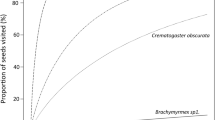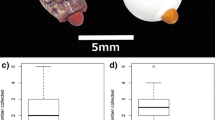Abstract
It has been proposed that chemicals on plant elaiosomes aid seed detection by seed-dispersing ants. We hypothesized that the chemical interaction between ants and elaiosomes is more intimate than a generic attraction, and that elaiosome chemicals will attract mutualistic but not granivorous ant species. We investigated this by using two gorse species, Ulex minor and U. europaeus, and two associated ant species from European heathlands, the mutualist Myrmica ruginodis and the granivore Tetramorium caespitum. Behavioral studies were conducted with laboratory nests and foraging arenas. Both ants will take Ulex seeds, but while M. ruginodis showed increased antennation toward ether extracts of elaiosome surface chemicals compared with controls, T. caespitum showed no response. Elaiosome extracts were separated into seven lipid fractions. M. ruginodis showed increased antennation only toward the diglyceride fractions of both Ulex species, whereas T. caespitum showed no consistent reaction. This indicates that M. ruginodis can detect the elaiosome by responding to its surface chemicals, but T. caespitum is unresponsive to these chemicals. Responses to surface chemicals could increase the rate of seed detection in the field, and so these results suggest that Ulex elaiosomes produce chemicals that facilitate attraction of mutualistic rather than granivorous ant species. This could reduce seed predation and increase Ulex fitness.
Similar content being viewed by others
References
Andersen, A. N. 1988. Soil of the nest-mound of the seed-dispersing ant, Aphaenogaster longiceps, enhances seedling growth. Aust. J. Bot. 13:469–471.
Beattie, A. J. 1985. The Evolutionary Ecology of Ant–Plant Mutualisms. Cambridge University Press, Cambridge.
Beattie, A. J. 1991. Problems outstanding in ant-plant interaction research, pp. 559–576, in C. R. Huxley and D. F. Cutler (eds.). Ant–Plant Interactions. 1 ed. Oxford Science Publications, Oxford.
Bond, W. J., Yeaton, R., and Stock, W. D. 1991. Myrmecochory in Cape fynbos, pp. 448–462, in C. R. Huxley and D. F. Cutler (eds.). Ant–Plant Interactions. Oxford Scientific Publications, Oxford.
Bresinsky, A. 1963. Bau, Entwicklungsgeschichte und Inhaltsstoffe der Elaiosomen. Studien zur myrmekochoren Verbreitung von Samen und Fruechten. Bibl. Bot. 126:1–54.
Brew, C. R., Odowd, D. J., and Rae, I. D. 1989. Seed dispersal by ants—behavior-releasing compounds in elaiosomes. Oecologia 80:490–497.
Brian, M. V. 1964. Ant distribution in a Southern heath. J. An. Ecol. 25:319–337.
Brian, M. V. 1977. Ants. Collins, London.
Brian, M. V. and Abbott, A. 1977. The control of food flow in a society of the ant Myrmica rubra L. Anim. Behav. 25:1047–1055.
Christian, C. E. and Stanton, M. L. 2004. Cryptic consequences of a dispersal mutualism: Seed burial, elaiosome removal, and seed-bank dynamics. Ecology 85:1101–1110.
Davidson, D. W. and Morton, S. R. 1981. Myrmecochory in some plants (F. Chenopodiaceae) of the Australian arid zone. Oecologia 50:357–366.
De Moraes, C. M., Mescher, M. C., and Tumlinson, J. H. 2001. Caterpillar-induced nocturnal plant volatiles repel conspecific females. Nature 410:577–580.
Elmes, G. W., Wardlaw, J. C., Schönrogge, K., Thomas, J. A., and Clarke, R. T. 2004. Food stress causes differential survival of socially parasitic caterpillars of Maculinea rebeli integrated in colonies of host and non-host Myrmica ant species. Entomol. Exp. Appl. 110:53–63.
Espadaler, X. and Gomez, C. 1996. Seed production, predation and dispersal in the Mediterranean myrmecochore Euphorbia characias (Euphorbiaceae). Ecography 19:7–15.
Espadaler, X. and Gomez, C. 1997. Falling or movement of seeds and the presence of an elaiosome: Its affect on ant reaction (Hymenoptera: Formicidae) in a myrmecochorous species, Euphorbia characias (Euphorbiaceae). Sociobiology 30:175–183.
Gammans, N., Bullock, J. M., and Schönrogge, K. 2005. Ant benefits in a seed dispersal mutualism. Oecologia 146:43–49.
Gomez, C. and Espadaler, X. 1998. Myrmecochorous dispersal distances: A world survey. J. Biogeogr. 25:573–580.
Gordon, D. M. 1983. Dependence of necrophoric response to oleic-acid on social-context in the ant Pogonomyrmex badius. J. Chem. Ecol. 9:105–111.
Handel, S. N. and Beattie, A. J. 1990. Seed dispersal by ants. Sci. Am. 263:76.
Heinken, T. 2004. Migration of an annual myrmecochore: A four year experiment with Melampyrum pratense. Plant Ecol. 150:55–72.
Hölldobler, B. and Wilson, E. O. 1990. The Ants. Belknap, Harvard.
Hughes, L. and Westoby, M. 1992. Effect of diaspore characteristics on removal of seeds adapted for dispersal by ants. Ecology 73:1300–1312.
Hulme, P. E. 2002. Seed-eaters: Seed dispersal, destruction and demography, pp. 257–273, in D. J. Levey, W. R. Silva, and M. Galleti (eds.). Seed Dispersal and Frugivory: Ecology, Evolution and Conservation. CAB International, Wallingford.
Kalunzy, M. A., Duncan, L. A., Merrit, M. V., and Epps, D. E. 1985. Rapid separations of lipid classes in high yield and purity using bonded phase columns. J. Lipid Res. 26:135–140.
Kjellsson, G. 1985. Seed fate in a population of Carex pilulifera .1. Seed dispersal and ant–seed mutualism. Oecologia 67:416–423.
Kusmenoglu, S., Rockwood, L. L., and Gretz, M. R. 1989. Fatty acids and diacylglycerols from elaiosomes of some ant-dispersed seeds. Phytochemistry 28:2601–2602.
Lanza, J., Schmitt, M. A., and Awad, A. B. 1992. Comparative chemistry of elaiosomes of three species of Trillium. J. Chem. Ecol. 18:209–221.
Mark, S. and Olesen, J. M. 1996. Importance of elaiosome size to removal of ant-dispersed seeds. Oecologia 107:95–101.
Marshall, D. L., Beattie, A. J., and Bollenbacher, W. E. 1979. Evidence for diglycerides as attractants in an ant–seed interaction. J. Chem. Ecol. 5:335–344.
Muller, C. and Riederer, M. 2005. Plant surface properties in chemical ecology. J. Chem. Ecol. 31:2621–2651.
Ohkawara, K., Ohara, M., and Higashi, S. 1997. The evolution of ant-dispersal in a spring-ephemeral Corydalis ambigua (Papaveraceae): Timing of seed-fall and effects of ants and ground beetles. Ecography 20:217–223.
Raine, N. E., Gammans, N., MacFadyen, I. J., Scrivner, G. K., and Stone, G. N. 2004. Guards and thieves: Antagonistic interactions between two ant species coexisting on the same ant–plant. Ecol. Entomol. 29:345–352.
Retana, J., Pico, F. X., and Rodrigo, A. 2004. Dual role of harvesting ants as seed predators and dispersers of a non-myrmechorous Mediterranean perennial herb. Oikos 105:377–385.
Rice, B. and Westoby, M. 1986. Evidence against the hypothesis that ant-dispersed seeds reach nutrient-enriched microsites. Ecology 67:1270–1274.
Sheridan, S. L., Iversen, K. A., and Itagakis, H. 1996. The role of chemical senses in seed-carrying behaviour by ants: A behavioural, physiological and morphological study. J. Insect Physiol. 42:149–159.
Skidmore, B. A. and Heithaus, E. R. 1988. Lipid cues for seed-carrying by ants in Hepatica americana. J. Chem. Ecol. 14:2185–2196.
Skinner, G. J. 1987. Ants of the British Isles. Shire Publishing, Buckinghamshire.
Slingsby, P. and Bond, W. J. 1981. Ants—Friends of the Fynbos. Veld Flora 67:39–45.
Stokes, K. E., Bullock, J. M., and Watkinson, A. R. 2003. Ulex gallii Planch. and Ulex minor Roth. Biological Flora of the British Isles. J. Ecol. 91:1106–1124.
Thomas, J. A., Knapp, J. J., Akino, T., Gerty, S., Wakamura, S., Simcox, D. J., Wardlaw, J. C., and Elmes, G. W. 2002. Insect communication: Parasitoid secretions provoke ant warfare—Subterfuge used by a rare wasp may be the key to an alternative type of pest control. Nature 417:505–506.
Wardlaw, J. C. and Elmes, G. W. 1996. Exceptional colony size in Myrmica species (Hymenoptera: Formicoidea). Entomologist 115:191–196.
Wardlaw, J. C., Elmes, G. W., and Thomas, J. A. 1998. Techniques for studying Maculinea butterflies: 1. Rearing Maculinea caterpillars with Myrmica ants in the laboratory. J. Insect Conserv. 2:79–84.
Weissburg, M. J., Ferner, M. C., Piscut, D. P., and Smee, D. L. 2002. Ecological consequences of chemically mediated prey perception. J. Chem. Ecol. 28:1953–1970.
Wilson, E. O., Durlach, N. I., and Roth, L. M. 1958. Chemical releasers of necrophoric behaviour in ants. Psyche 65:108–114.
Acknowledgments
We thank Sophie Everett, Andrew Worgan, and Emma Napper for help and advice with the chemical protocols; Michael Fenner and Judith Wardlaw for criticisms; and Francis Haynes for her help. Two anonymous referees gave useful criticisms. This study was funded by the UK Natural Environment Research Council research studentship to Nicola Gammans, NER/S/A/2002/11078.
Author information
Authors and Affiliations
Corresponding author
Rights and permissions
About this article
Cite this article
Gammans, N., Bullock, J., Gibbons, H. et al. Reaction of Mutualistic and Granivorous Ants to Ulex Elaiosome Chemicals. J Chem Ecol 32, 1935–1947 (2006). https://doi.org/10.1007/s10886-006-9119-7
Published:
Issue Date:
DOI: https://doi.org/10.1007/s10886-006-9119-7




